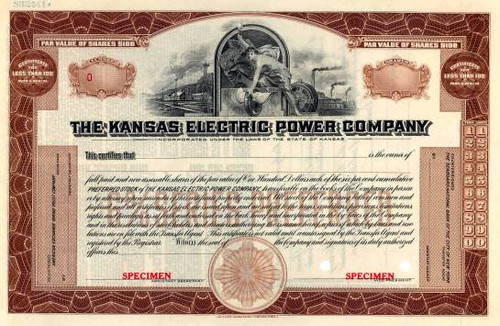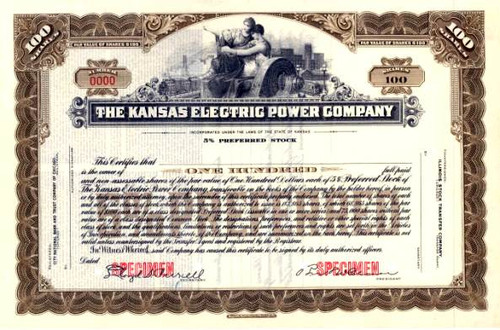Beautifully engraved SPECIMEN certificate from the Empire District Electric Company. This historic document was printed by the Security Banknote Company in 1944 and has an ornate border around it with a vignette of an allegorical woman holding a light with the power plant in the background. This item has the printed signatures of the Company's President and Treasurer. 
Certificate Vignette Based in Joplin, Missouri, The Empire District Electric Company (NYSE:EDE) is an investor-owned utility providing electric service to approximately 150,000 customers in southwest Missouri, southeast Kansas, northeast Oklahoma, and northwest Arkansas. The Company also offers monitored security, fiber optic service, and decorative lighting services to its customers, and provides water service in three incorporated communities in Missouri. The history of The Empire District Electric Company is closely interwoven with the story of the development of this region. While Empire was organized in 1909, tracing its history takes us back beyond the turn of the century for a look at a growing mining industry in the area. The use of electrical power in the mining industry had been untried prior to 1890. Individual zinc and lead miners who had staked their claims used mules and hard labor to scratch out a living. The names of the mines, Yellow Dog, Grasshopper, Windy Bill, and the Morning Star, were as colorful as the people who worked them. As mining companies sprung up across the tri-state region, electrical motors began to replace the mule and steam power engines in several of the mines. Electrical generating companies were born in several locations across the region. These small companies appeared haphazardly to supply the new mining district with the power it demanded. On October 16, 1909, papers of incorporation were filed in Topeka, Kansas bringing the Consolidated Light, Power and Ice Company, the Spring River Power Company, The Galena Light and Power Company, and the Joplin Light, Power, and Water Company together to form a Company that would be known as The Empire District Electric Company, under its parent company, Cities Services. The formation of Empire marked the end of indiscriminate electrical development in the area, and was the beginning of a construction program designed to meet the needs of a growing region. The vision of the New York financiers who invested in this area is still alive today. Hoping to develop a financially feasible venture, they referred to this region as "Little Empire" or the "Empire District" to denote their pride in New York, the "Empire State." To this day, the name "Empire" represents the history of mining development in this area. At the time of its organization, Empire had 109 miles of transmission line, 8 megawatts of generating capacity, and 2,400 customers. Today, the Company utilizes over 1,200 miles of transmission line and over 1000 megawatts of capacity to serve over 150,000 customers. As industry grew and families moved into the four-state region, the demand for electrical power grew as well. Electrical power for Empire was first produced from generation at the Lowell and Redings Mill hydroelectric plants. Soon, however, the demand for more generation became evident. In the summer of 1909, work began on the Riverton Generating Station. Nine months later, it was completed. One of the generators at the plant was dubbed "Old Kate." Kate was famous for supplying power to the St. Louis World's Fair in 1904. Today, the Riverton Plant is still in operation, generating 136 megawatts of electricity. With its five turbines, the Riverton generating station is one of the oldest operational power plants in the United States. Although the plant was flooded in 1993 by the overflow of Spring River, it remains today a vital part of Empire's generation mix. Construction of the Ozark Beach Dam began in 1911 in Taney County, Missouri. Two years later, the dam was completed. It is 1,300 feet long and forms Lake Taneycomo, which stretches for 22 miles. Today, Ozark Beach Hydroelectric Plant supplies Empire with 16 megawatts of power and the Taney County area with a beautiful recreational area. Empire Park, located just above the dam, is a recreational park maintained by Empire District. In 1999, the park was honored with the annual Advisory Council on Disabilities Community Award for the refurbishment and addition of handicap accessible facilities. In 1944, The Empire District Electric Company separated from its parent company to become an independent company with its stock listed on the New York Stock Exchange. From 1910 to its independence from Cities Services, Empire had purchased 27 separate power companies to become the dominant provider of electric service in the region. From 1959 to 1966, Empire spent approximately 25-million dollars on construction, mostly on new transmission and distribution facilities, to handle the increased demand for electric energy. This construction program included new high-voltage transmission lines and new substations. It also included new transmission lines to tie Empire's system with neighboring electric companies, making Empire an important part of a vast power grid embracing the Midwest. In the early 60's, the need for more automation in Empire's operations was apparent. This brought about the construction of an operations and communications center in Joplin. System Operations was completed in 1964. Equipped with the latest design in electronic technology, this nerve center monitors and controls the production and power flow throughout the entire Empire system. By the mid 1960's, the energy needs of this growing and diverse economic region would once again exceed the capacity of existing generation facilities. On September 10, 1967, just north of the town of Asbury, Missouri, ground was broken for a 200-megawatt, coal-fired power plant. The $26-million Asbury Generating Station was put into operation in June of 1970. Asbury was designed as a "mine-mouth" plant to burn coal from the Empire Mine located just north of the plant. Total plant capacity is 213 megawatts. Unit One is rated at 193 megawatts. Unit Two, completed in 1986, generates 20 megawatts of electricity from the excess boiler capacity of Unit One. In 1990, the plant was converted to use a blend of low-sulfur Wyoming coal and native coal to comply with new clean air standards. In 1997, Asbury set a continuous run record of 170 days. It was a remarkable feat, considering the 27-year age of the plant. Today, Asbury remains one of the lowest cost generating plants in the Midwest. In 1978, Empire added the first of two 90-megawatt combustion turbine peaking units at the Empire Energy Center near LaRussell, Missouri - some twenty miles east of Joplin. An opportunity to purchase 12%, or 80 megawatts, of the 650 megawatt Iatan Power Plant, near Kansas City, postponed the addition of a second 90 megawatt unit at the Empire Energy Center until 1981. Although these units originally utilized only fuel oil for combustion, they were converted to use natural gas in 1994. To meet the demand for even more energy, in 1993 Empire announced the addition of the State Line Power Plant located west of Joplin. A 98-megawatt combustion turbine began providing energy to Empire's customers in May of 1995. Two years later, a second 150-megawatt turbine was added to the State Line power plant. Plans were announced in 1998 for construction of an additional 350 megawatts of electric power generation at State Line. A new 150-megawatt combustion turbine, combined with the existing 150-megawatt unit, generate enough waste heat to produce an additional 200 megawatts of steam-powered, combined-cycle energy. The combined cycle unit began providing energy to Empire customers in June 2001. Westar Generating, Inc., a wholly own subsidiary of Western Resources, Topeka, Kansas, is a partner in the State Line combined cycle. Empire owns 60 percent and is the operator of the plant. Total plant output at State Line is 600 megawatts, making it Empire's highest megawatt-output power plant. All three combustion turbines at State Line Power Plant use natural gas. In recent years, Empire has expanded its range of services to include monitored security, fiber optics, and parking lot and sports field lighting. The history of The Empire District Electric Company during its ninety-plus year existence has proven the vision and wisdom of its founders. With the dedication and professionalism of its employees through the years, Empire has fulfilled its mission to provide safe, reliable, and low-cost electric energy to homes and industry alike. From its early beginnings, Empire has been a good corporate citizen while providing a fair return for its owners, the stockholders. The Company has used technical improvements to produce and deliver energy more efficiently while maintaining the quality of the environment for future generations. And, Empire has maintained some of the lowest electric rates in the nation while taking the lead in community and industrial development. From the early mining camps to the diverse array of industry found across the four-state region today, the "Empire District" is alive and thriving, in no small part, due to the leadership, courage, and spirit of The Empire District Electric Company. Company background and historical Information is from the company's press releases.

Certificate Vignette










